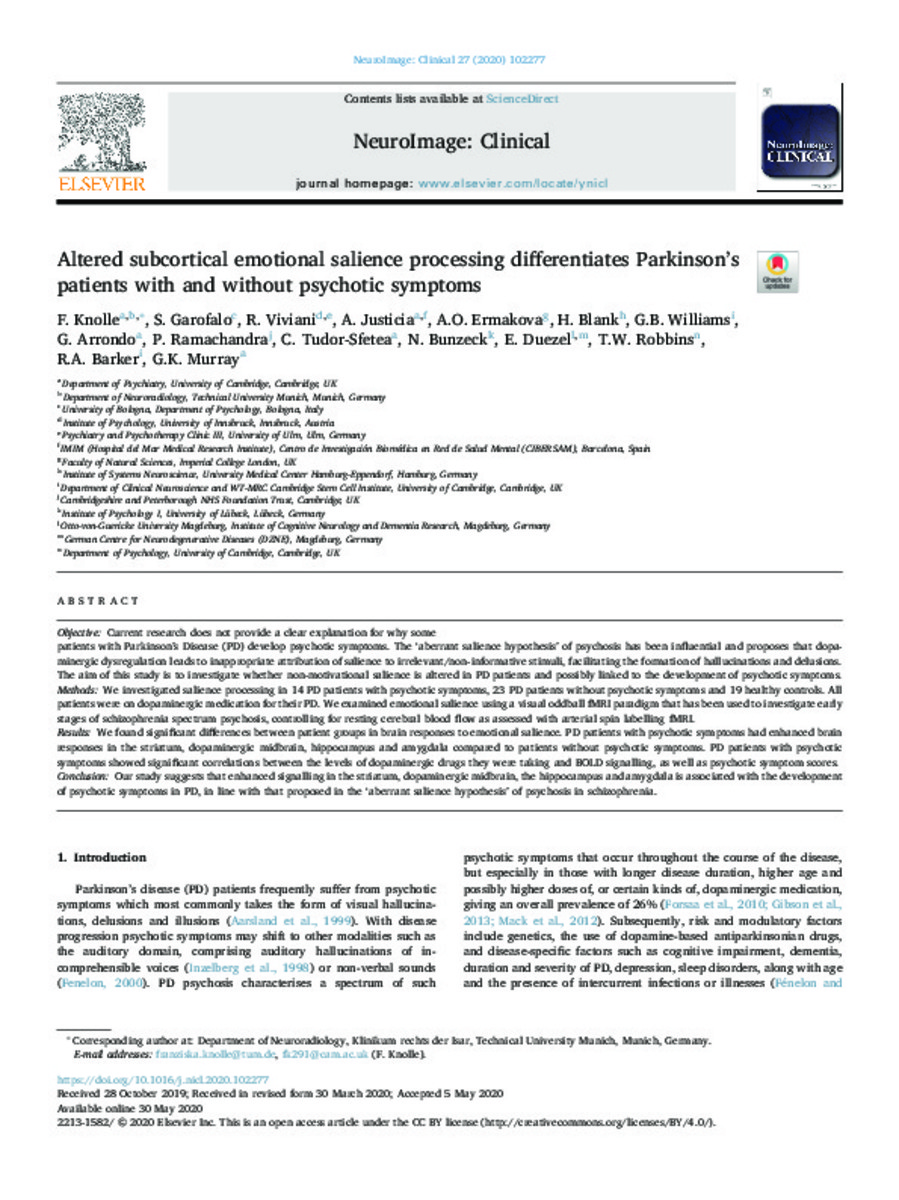Full metadata record
| DC Field | Value | Language |
|---|---|---|
| dc.creator | Knolle, F. (F.) | - |
| dc.creator | Garofalo, S. (Sara) | - |
| dc.creator | Viviani, R. (R.) | - |
| dc.creator | Justicia, A. (Azucena) | - |
| dc.creator | Ermakova, A.O. (Anna O.) | - |
| dc.creator | Blank, H. (H.) | - |
| dc.creator | Williams, G. B. (G. B.) | - |
| dc.creator | Arrondo, G. (Gonzalo) | - |
| dc.creator | Ramachandra, P. (Pranathi) | - |
| dc.creator | Tudor-Sfetea, C. (Carina) | - |
| dc.creator | Bunzeck, N. (N.) | - |
| dc.creator | Duezel, E. (E.) | - |
| dc.creator | Robbins, T.W. (Trevor W.) | - |
| dc.creator | Barker, R.A. (Roger A.) | - |
| dc.creator | Murray, G.K. (Graham K.) | - |
| dc.date.accessioned | 2020-07-30T08:26:56Z | - |
| dc.date.available | 2020-07-30T08:26:56Z | - |
| dc.date.issued | 2020 | - |
| dc.identifier.citation | Knolle, F., Garofalo, S., Viviani, R., Justicia, A., Ermakova, A. O., Blank, H., Williams, G. B., Arrondo, G., Ramachandra, P., Tudor-Sfetea, C., Bunzeck, N., Duezel, E., Robbins, T. W., Barker, R. A., & Murray, G. K. (2020). Altered subcortical emotional salience processing differentiates Parkinson’s patients with and without psychotic symptoms. NeuroImage: Clinical, 27, 102277 | es_ES |
| dc.identifier.issn | 2213-1582 | - |
| dc.identifier.uri | https://hdl.handle.net/10171/59135 | - |
| dc.description.abstract | Objective Current research does not provide a clear explanation for why some patients with Parkinson’s Disease (PD) develop psychotic symptoms. The ‘aberrant salience hypothesis’ of psychosis has been influential and proposes that dopaminergic dysregulation leads to inappropriate attribution of salience to irrelevant/non-informative stimuli, facilitating the formation of hallucinations and delusions. The aim of this study is to investigate whether non-motivational salience is altered in PD patients and possibly linked to the development of psychotic symptoms. Methods We investigated salience processing in 14 PD patients with psychotic symptoms, 23 PD patients without psychotic symptoms and 19 healthy controls. All patients were on dopaminergic medication for their PD. We examined emotional salience using a visual oddball fMRI paradigm that has been used to investigate early stages of schizophrenia spectrum psychosis, controlling for resting cerebral blood flow as assessed with arterial spin labelling fMRI. Results We found significant differences between patient groups in brain responses to emotional salience. PD patients with psychotic symptoms had enhanced brain responses in the striatum, dopaminergic midbrain, hippocampus and amygdala compared to patients without psychotic symptoms. PD patients with psychotic symptoms showed significant correlations between the levels of dopaminergic drugs they were taking and BOLD signalling, as well as psychotic symptom scores. Conclusion Our study suggests that enhanced signalling in the striatum, dopaminergic midbrain, the hippocampus and amygdala is associated with the development of psychotic symptoms in PD, in line with that proposed in the ‘aberrant salience hypothesis’ of psychosis in schizophrenia. | es_ES |
| dc.description.sponsorship | This study was supported by a MRC Clinician Scientist [G0701911] and an Isaac Newton Trust award to G.K.M., and by the Cambridge NIHR Biomedical Research Centre; and by the European Union’s Horizon 2020 to F.K. [754462]. T.W.R. discloses consultancy with Cambridge Cognition, Unilever and Greenfield Bioventures; he receives royalties from Cambridge Cognition, research grants from Shionogi & Co and GlaxoSmithKline, and editorial honoraria from Springer Nature and Elsevier. | es_ES |
| dc.language.iso | eng | es_ES |
| dc.publisher | Elsevier | es_ES |
| dc.relation | info:eu-repo/grantAgreement/EC/H2020/754462/EU | es_ES |
| dc.relation | info:eu-repo/grantAgreement/UKRI/MRC/G0701911/GB | - |
| dc.rights | info:eu-repo/semantics/openAccess | es_ES |
| dc.subject | Parkinson’s Disease | es_ES |
| dc.subject | Psychotic symptoms | es_ES |
| dc.title | Altered subcortical emotional salience processing differentiates Parkinson’s patients with and without psychotic symptoms | es_ES |
| dc.type | info:eu-repo/semantics/article | es_ES |
| dc.editorial.note | This is an open access article under the CC BY license (http://creativecommons.org/licenses/BY/4.0/) | es_ES |
| dc.identifier.doi | https://doi.org/10.1016/j.nicl.2020.102277 | es_ES |
| dadun.citation.endingPage | 10 | es_ES |
| dadun.citation.publicationName | NeuroImage: Clinical | es_ES |
| dadun.citation.startingPage | 1 | es_ES |
| dadun.citation.volume | 27 | es_ES |
Files in This Item:
Statistics and impact
Items in Dadun are protected by copyright, with all rights reserved, unless otherwise indicated.






